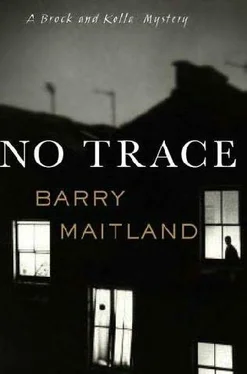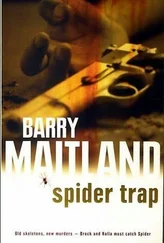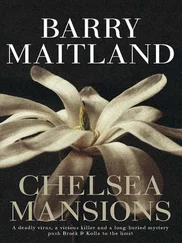Barry Maitland - No trace
Здесь есть возможность читать онлайн «Barry Maitland - No trace» весь текст электронной книги совершенно бесплатно (целиком полную версию без сокращений). В некоторых случаях можно слушать аудио, скачать через торрент в формате fb2 и присутствует краткое содержание. Жанр: Полицейский детектив, на английском языке. Описание произведения, (предисловие) а так же отзывы посетителей доступны на портале библиотеки ЛибКат.
- Название:No trace
- Автор:
- Жанр:
- Год:неизвестен
- ISBN:нет данных
- Рейтинг книги:4 / 5. Голосов: 1
-
Избранное:Добавить в избранное
- Отзывы:
-
Ваша оценка:
- 80
- 1
- 2
- 3
- 4
- 5
No trace: краткое содержание, описание и аннотация
Предлагаем к чтению аннотацию, описание, краткое содержание или предисловие (зависит от того, что написал сам автор книги «No trace»). Если вы не нашли необходимую информацию о книге — напишите в комментариях, мы постараемся отыскать её.
No trace — читать онлайн бесплатно полную книгу (весь текст) целиком
Ниже представлен текст книги, разбитый по страницам. Система сохранения места последней прочитанной страницы, позволяет с удобством читать онлайн бесплатно книгу «No trace», без необходимости каждый раз заново искать на чём Вы остановились. Поставьте закладку, и сможете в любой момент перейти на страницу, на которой закончили чтение.
Интервал:
Закладка:
‘Did he say Beaufort?’ Brock whispered to Chivers.
Cheery gave him a baleful look to see if he was joking, then reached to Brock’s copy of the report and turned to the introduction. Listed were the names of the committee of inquiry headed by its chair, Sir John Beaufort.‘Jugular Jack,’ Chivers snorted.
‘Something, Brock?’ Sharpe was leaning forward over his papers, beaming his piercing stare down the length of the conference table.
‘Just that I happened to come across Beaufort today. He’s got Special Branch protection, you know. He’s been getting death threats.’
‘Well, let’s hope they come to something,’ Sharpe said acidly.‘I suppose we can always consider that as a last resort. Murder is one thing we should be able to do reasonably well. No, Lillian, that’s not to be minuted.’ He allowed time for appreciative chortles around the table before moving to the next item on his long agenda. n the following days the initial turbulent activity settled into a pattern. New faces became familiar, actions became routine and the hope of quick results faded into a dull frustration. The weather settled too, into the soggy monochrome of autumn; leaves fell in earnest from the trees and people reached automatically for warm coats as if summer had never been.
Kathy continued to visit Northcote Square each day, although no one seriously expected Gabriel Rudd to hear from his daughter’s kidnapper. She became part of the background at 53 Urma Street, saying little but watching and listening in the hope of catching some reference that might be useful in the hunt for Tracey. She found that the enigma of Gabriel Rudd became no clearer to her. She attended a number of impassioned interviews he gave to radio, TV and press reporters in his house, in which he spoke agonisingly of his loss and pleaded with heart-wrenching conviction for his daughter’s safe return. She also observed the careful way in which he positioned his interviewers and their photographers so that his studies for The Night-Mare always appeared to good effect in the background. She noticed that he encouraged certain styles of photograph of himself, in close close-up, or in apparent conversation with his work, and she was struck by his change of mood when the interviewers left, becoming brisk and focused on his preparations for the exhibition at The Pie Factory, which seemed to absorb all his attention. It was as if she were watching two quite separate movies spliced together, one of a shocking family tragedy and the other of the artist at work.
Kathy also learned a good deal about Rudd’s creative process, which she found surprising. She had assumed that artists worked pretty much in isolation, applying their individual skills and inspiration to the material at hand, but it turned out that Rudd’s work was fabricated by other people, a whole army of collaborators or subcontractors acting under his instructions. Some of them worked elsewhere, but many of them moved into 53 Urma Street and could be found in busy groups in the studio, or sprawled at meal breaks in the living room, or asleep in the bedrooms on the ground floor. When Kathy asked Rudd about this (‘You mean you don’t actually make your own works of art?’) he laughed and gave her a rambling explanation of his fundamental challenge to the whole meaning of artistic authentication, which she didn’t follow.‘I suppose you think this is dead easy, eh?’ he challenged her. ‘Wanking around dreaming up crazy ideas.’
‘I was wondering how you know when you’ve got a good one, how you can tell a good idea from a less good one.’
‘Interesting question. I just do. That’s why I’m here, doing this. Sometimes it scares me rigid.’
His mood swung from garrulous to glum, and she was pretty sure that Poppy was bringing him drugs of some kind.
She liked the crew of assistants, who seemed a more light-hearted version of the police teams, industrious and painstaking and concerned with practical matters of obtaining things and making them work. They joked about Rudd’s conceptual pretensions behind his back and ignored his tantrums when things weren’t to his satisfaction, and it was from them that Kathy began to glean an idea of what he was preparing for the exhibition. It seemed to be a play on the word ‘trace’-the missing girl Trace, lost without a trace, and the artwork itself in the form of tracings. These would be images and words transferred by various processes onto sheets of plastic tracing film used in draughting offices, with a pale milky texture which would give a shimmering, ghostly effect under certain kinds of light.
Each day at eleven a.m. Kathy got a phone call from Len Nolan, polite but firm, wanting to know of any progress. She imagined the two grandparents sitting together over their morning coffee, ticking off the points on a list, determined not to be ignored by the authorities. Kathy also did follow-up interviews around the square, and came to recognise the ebb and flow of the people who moved through it, and put faces and characters to some of the names on the list of residents. The first she visited was Betty Zielinski, who was a common sight in the central gardens, feeding the birds with bread scraps she collected from Mahmed’s Cafe. At Kathy’s suggestion, she was taken into Betty’s home on West Terrace to meet her family, which turned out to be a fat black cat and a large collection of dolls, dozens in every room, each known by name and dressed eccentrically in clothes made by Betty on an old treadle sewing machine. Her sewing room was a chaotic jumble of home-made paper patterns and scraps of cloth. As she talked, Kathy tried to fathom her madness, if that’s what it was; a strange mixture of what seemed like normal memory and sensible observations with disconcerting interpretations, as if Betty stubbornly refused to see the world the same way as everybody else. There was an element of deliberate calculation in some of this, Kathy thought, and one or two of the disjunctions bothered her.
‘Tracey liked it here, with my little babies, in their mummy’s house. She helped me choose materials for their dresses. She loved coming to her mummy’s house.’
‘Her mummy’s house?’ Kathy queried, wondering if she’d misheard. Betty gave a startled little laugh, absurdly girlish and playful for a sixty-two year old.
‘We pretended that this was her mother’s house,’ Betty simpered, and Kathy remembered how she’d talked the previous day to Gabe about ‘my own little girl, my own darling’.
‘You knew Tracey’s mother, didn’t you?’
‘Of course. I’ve lived here for almost forty years, longer than anyone else. Longer even than…’ she cocked her head and whispered, ‘… the monster. Poor Jane. Such lovely long blonde hair. I was so jealous of her long blonde hair.’
‘What monster, Betty?’
‘Shhh! The children will hear you! They’re terrified of him. The one next door, of course.’ She nodded towards the wall to number fifteen, the portrait painter’s house. ‘Stolen!’ she wailed suddenly.‘So many stolen children!’
‘Reg Gilbey steals children?’
Again a look of surprise came over Betty’s face, as if some unexpected shift had occurred inside her head. ‘Oh dear me, no. My family took such a long time to get to sleep last night after all the excitement with the visitors. They simply wouldn’t settle.’
‘Which visitors were those?’
‘Why, the policemen and women, looking for Tracey. They searched in every room, but I told them they’d never find her here.’ Her eyes twinkled as if at the memory of a particularly exciting game of hide-and-seek. ‘Thomas became so excited he wet his pants, and Geraldine was sick all over her brand-new dress.’
Kathy could imagine what the lads from Shoreditch had made of that.
Читать дальшеИнтервал:
Закладка:
Похожие книги на «No trace»
Представляем Вашему вниманию похожие книги на «No trace» списком для выбора. Мы отобрали схожую по названию и смыслу литературу в надежде предоставить читателям больше вариантов отыскать новые, интересные, ещё непрочитанные произведения.
Обсуждение, отзывы о книге «No trace» и просто собственные мнения читателей. Оставьте ваши комментарии, напишите, что Вы думаете о произведении, его смысле или главных героях. Укажите что конкретно понравилось, а что нет, и почему Вы так считаете.












